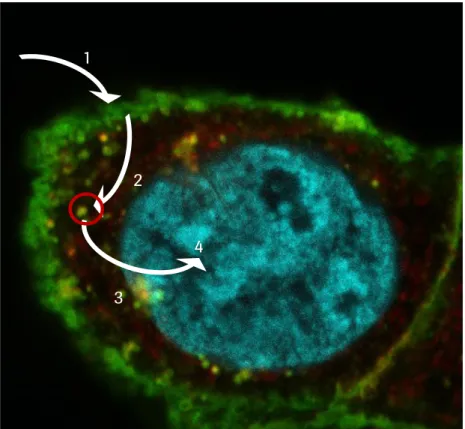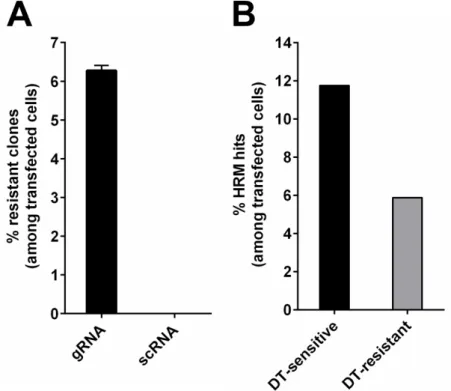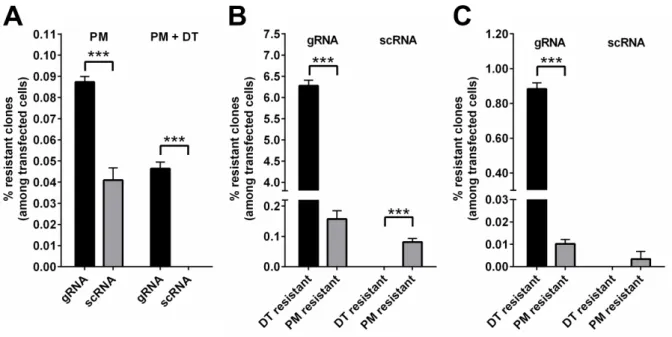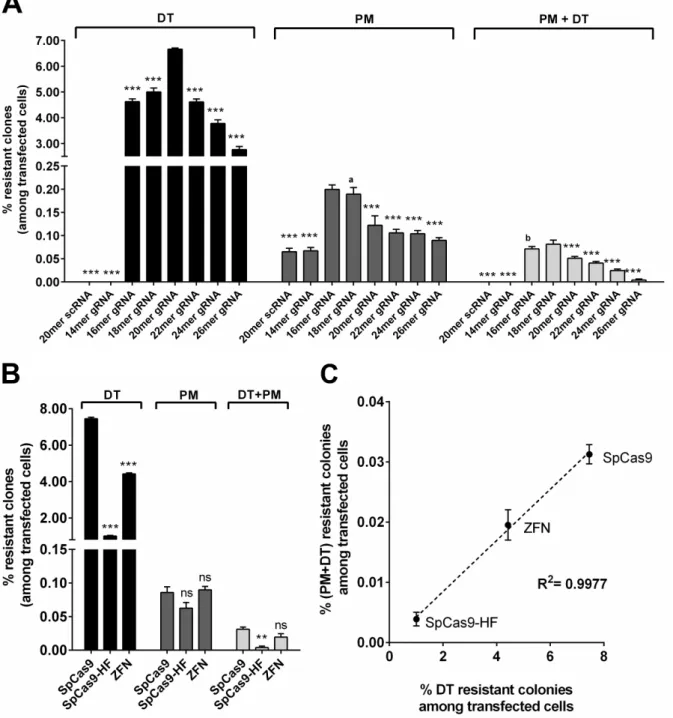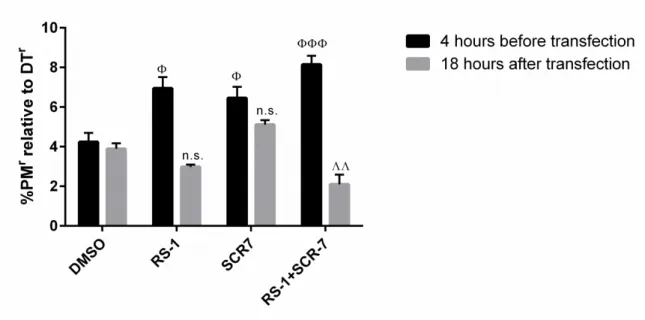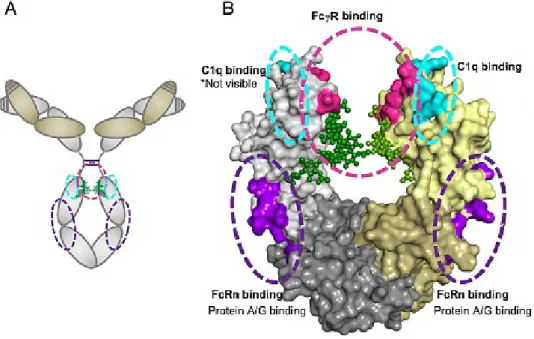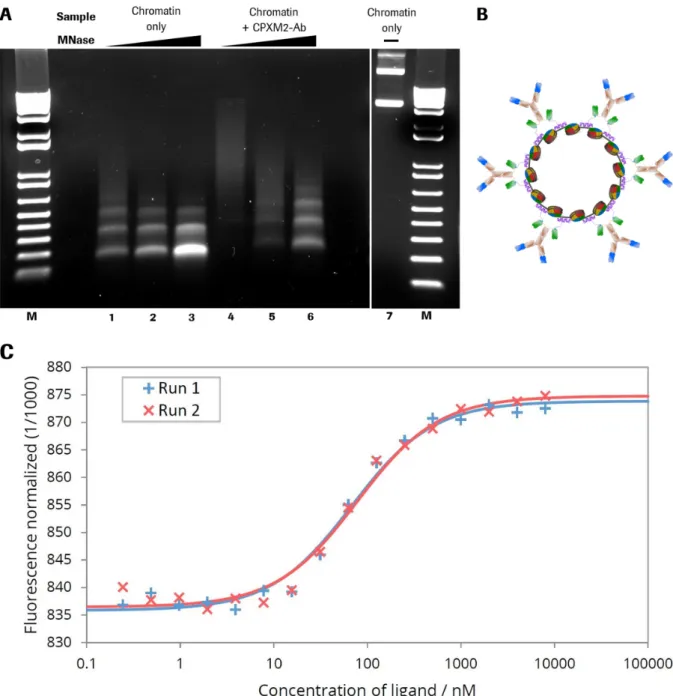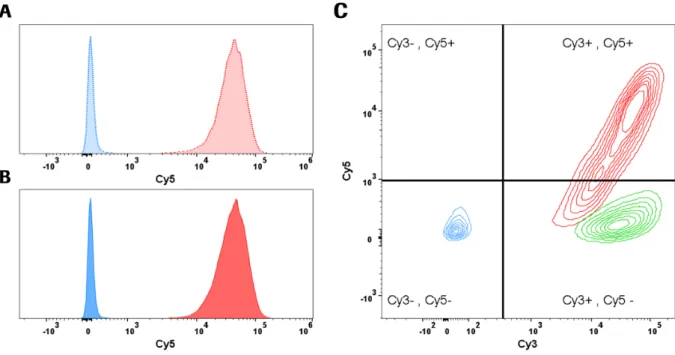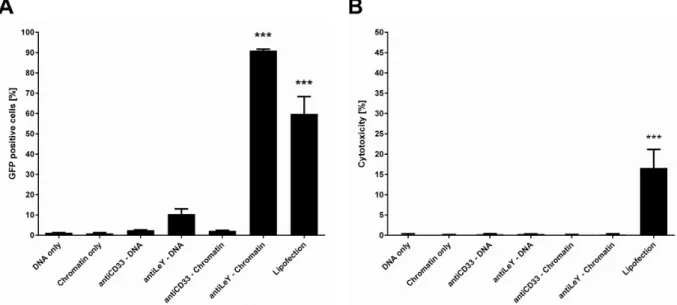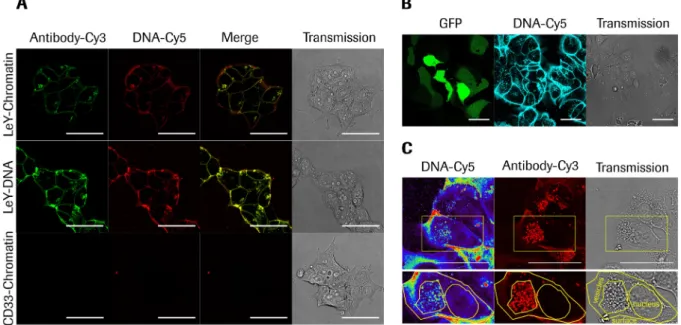Development, characterization and synthesis of multi-specific proteins for targeted delivery of
nucleic acids and nucleic acid derivatives
DISSERTATION
ZUR ERLANGUNG DES DOKTORGRADES DER NATURWISSENSCHAFTEN (DR. RER. NAT.) DER FAKULTÄT FÜR BIOLOGIE UND VORKLINISCHE
MEDIZIN DER UNIVERSITÄT REGENSBURG
vorgelegt von
Tobias Friedrich Killian aus Eichstätt
April 2019
ii
iii
Das Promotionsgesuch wurde eingereicht am 02.04.2019.
Die Arbeit wurde angeleitet von Prof. Dr. Reinhard Sterner.
Unterschrift:
iv
v
Summary
The focus of this PhD thesis is the development of a novel strategy for specific and efficient delivery of gene expression systems for targeted genome editing. To mediate efficient transgene expression only inside the nuclei of the cells of interest, an optimization of every step along the gene delivery route as outlined in the following is absolutely mandatory:
1. Specific delivery to the target cells 2. Efficient translocation to the nucleus
3. Expression and functionality of the gene product
To structure this comprehensive research project, the thesis is divided into three individually addressed work packages according to the delivery route but in a strategic reasonable order.
First of all, the functionality of the gene expression system must be quantifiable in a robust and simple manner to enable optimization of the preceding steps. For the delivery of reporter genes various robust methods for quantification exist like GFP expression and its evaluation via flow cytometry for example.
However, the final goal of this thesis is the delivery of targeted genome editing systems like CRISPR/Cas9. Quantification of gene editing is often combined with time consuming assays or is based on low overall numbers. To address this bottleneck, an assay for robust quantification of a huge number of individual genome editing events has been developed. This assay exploits cell survival and subsequent colony formation due to gain of toxin resistance for the quantification of transgene integration and homozygous gene inactivation. For transgene integration, puromycin-N- acetyltransferase gene is the transgene of choice, as integration events can be quantified by cell survival and colony formation after puromycin selection. Homozygous gene inactivation is quantified by targeting of genes essential for diphthamide synthesis, followed by diphtheria toxin selection and quantification of toxin resistant survivor cell colonies. Highlight of this assay is the determination of the absolute editing frequencies mediated by CRISPR/Cas9 and the demonstration that CRISPR/Cas9 editing efficiencies are comparable to the efficiencies of zinc finger nucleases. On the basis of the determined frequencies it is reasoned that site specific integration events with an absolute ratio of 0.12%
are too infrequent for therapeutic application. Homozygous knock out with 6% frequency on the other
hand might be considered for therapy if not every cell needs to be addressed and is therefore selected in
this thesis for further development of a targeted gene delivery system. All in all, this assay provides the
basis for the evaluation of the developed gene delivery system.
vi
Specific transgene expression exclusively in the tissue or cells of interest presupposes membrane binding and internalization predominantly at the target cells, the focus of the second work package. Such discrimination between target and non-target cells can be realized by antibodies or antibody derivatives.
For flexible coupling of payloads like nucleic acids with ability for intracellular release, bispecific hapten binding antibody formats are used. These antibody derivatives comprise specificity against the cell surface antigen and a second specificity against a hapten like biotin or digoxigenin. Haptenylation of DNA or DNA binding entities generates a flexible platform with ability to compare various antibody formats or payloads. The design, production, purification and characterization are the fundamental steps for the development of every antibody or antibody derivative and are described with the novel hapten binding TriFab format. Furthermore, the broad applicability of the hapten system is demonstrated by targeted delivery of various payloads like small molecules, nucleic acids or proteins by the TriFab in comparison to the bivalent and bispecific antibody format. The characteristics of the different antibody formats and the rationale of particular engineering aspects are discussed.
After demonstration that the hapten system is suitable for intracellular delivery of various compounds,
compatibility of this system for gene delivery is investigated. To facilitate nuclear delivery of plasmid
DNA, this large double stranded circular nucleic acid is organized into plasmid chromatin via histone
assembly by salt gradient dialysis. The properties favored for efficient and functional translocation of
plasmid DNA into the nucleus like improved nuclease resistance and charge reduction are demonstrated
after generation of high quality chromatin. The connection between chromatin and hapten binding
antibody derivatives was realized by a DNA binding peptide (CPXM2 peptide) derived from human
carboxypeptidase-like protein X2 (CPXM2 protein). Comparison of TriFab and bivalent bispecific
antibodies in combination with the haptenylated DNA binding peptide outlined that the latter format has
greater affinity to DNA most likely due to bivalent peptide / DNA interaction and is therefore chosen
for further characterization and development. It could be demonstrated that this antibody-peptide
complex is able to target plasmid DNA and plasmid chromatin with similar efficiency and high
specificity to the target cells. The impact of histone mediated DNA condensation was pointed out by
comparison of reporter gene expression. Plasmid DNA targeting did not result in a significant number
of transgene expressing cells, whereas targeted plasmid chromatin generated high portions of reporter
gene expressing cells. Finally, the initially developed assay is used to evaluate the compatibility of
plasmid chromatin targeting with CRISPR/Cas9 genome editing systems. The significant number of cell
clones with homozygous target gene knock out proves the applicability of this system for efficient
delivery of targeted genome editing. Moreover, the high specificity of the delivery system to the target
cells might open up a novel strategy for systemic application of a genome editing system for gene
therapy. In conclusion, this thesis describes the development of a novel system for specific and efficient
gene delivery with components exclusively of human or mammalian origin.
vii
Zusammenfassung
Die vorliegende Doktorarbeit befasst sich mit der Entwicklung eines Systems für die gezielte Verabreichung von Transgenen zur spezifischen, therapeutischen Genom-Editierung. Damit ein Gentherapeutikum systemisch optimal wirksam ist, müssen drei Schritte gezielt adressiert werden:
1. Spezifische Aufnahme des Transgens allein durch die Zielzelle 2. Effiziente Translokation des Transgens in den Nukleus
3. Expression und Funktionalität des therapeutischen Genprodukts
Auf diese Weise wurde auch das Forschungsprojekt strukturiert, wodurch drei Arbeitspakete entstanden, die nacheinander adressiert werden konnten. Die Reihenfolge der Bearbeitung wurde strategisch so gelegt, dass zunächst die Funktionalität des Genprodukts quantitativ bestimmt werden konnte, um anschließend die ersten beiden Schritte validieren zu können. Diese Quantifizierung ist im Falle von Reportergenen relativ einfach, da viele verschiedene und robuste Methoden etabliert sind. Ein Beispiel ist die Expression des GFP Reportergens und die schnelle und präzise Quantifizierung der GFP exprimierenden Zellen mittels Durchflusszytometrie. In dieser Arbeit soll final jedoch ein System zur Genom-Editierung wie beispielsweise das CRISPR/Cas9 System verwendet werden. Für die Quantifzierung von Genom-Editierung sind einfache und robuste Methoden bislang jedoch kaum vorhanden. Vielmehr sind die quantitativen Auswertungen der verschiedenen Editierungsereignisse meist verbunden mit zeitintensiven Methoden und basieren meist auf eher geringen absoluten Zahlen.
Um diesen Bedarf zu decken wurde im Zuge dieser Arbeit zunächst eine Methode entwickelt, mit der
Genom-Editierung basierend auf einer hohen Anzahl an Events robust quantifiziert werden kann. Diese
Methode basiert auf das Vermitteln von Toxinresistenzen durch Genom-Editierung. Zellen, die durch
Genom-Editierung Toxin resistent wurden, überleben die Behandlung mit entsprechenden Toxinen und
wachsen zu Kolonien heran, die am Ende quantifiziert werden können. Für die Quantifizierung der
Geninaktivierung wurden Genomeditierungssysteme gegen Gene gerichtet, die essentiell für die
Synthese von Diphthamid sind. Das homozygote Inaktivieren dieser Gene führt zur Resistenz gegen
Diphtherie Toxin, wodurch diese Editierungsereignisse durch Toxinselektion und Kolonieformierung
quantifiziert werden können. Die genomische Integration eines Transgens für Puromyzin-N-
Azetyltransferase vermittelt hingegen permanente Resistenz gegen Puromyzin, wodurch
Integrationsevents duch Puromyzinselektion quantifiziert werden können. Besonders hervorzuheben bei
dieser Methode ist, dass dadurch ermöglich wird absolute Häufigkeiten der verschiedenen
Editierungsevents vermittelt durch CRISPR/Cas9 zu bestimmen und auch mit weiteren Systemen wie
Zinkfinger Nukleasen zu vergleichen. Des Weiteren ist mit dieser Methode gezeigt, dass Zinkfinger
Nukleasen Genom-Editierung ähnlich effizient vermitteln wie das CRISPR/Cas9 System. Zudem wurde
viii
auf Grund dieser Häufigkeiten schnell ersichtlich, dass ortsgerichtete Integration von Transgenen mit einer Häufigkeit von 0.12% zu selten auftritt, um therapeutisch Anwendung zu finden. Homozygote Geninaktivierung mit einer Wahrscheinlichkeit von 6% hingegen kann durchaus für eine therapeutische Anwendung in Erwägung gezogen werden, vor Allem wenn nicht jede Zielzelle erfolgreich editiert werden muss um eine therapeutische Wirkung zu erzielen. Auf Grund der beschriebenen Vorteile und der umfangreichen Validierung wird diese Methode für die Entwicklung und Charakterisierung eines effizienten und gerichteten Gentherapiesystems verwendet.
Spezifische Transgenexpression durch das Zielgewebe oder die Zielzellen ist hauptsächlich dadurch bedingt, dass das Transgen vornehmlich an diesen Zellen bindet und von diesen internalisiert wird. Diese Unterscheidung zwischen Ziel- und Nicht-Zielzelle kann durch Antikörper beziehungsweise Antikörperderivate ermöglicht werden. Dafür und für die flexible Verbindung von Antikörper und die Entität, die spezifisch zur Zielzelle gebracht werden soll, wurden bis-spezifische, Hapten bindende Antikörperformate verwendet. Diese Antikörperderivate binden mit einer Spezifität das Zelloberflächenantigen und mit einer weiteren Spezifität ein Hapten, beispielsweise Biotin oder Digoxigenin. In Kombination mit haptenylierter Nukleinsäure oder haptenylierten DNA bindenden Entitäten wurde ein flexibles System generiert, dass ein einfaches Austauschen von Antikörper und Nukleinsäure sowie das Vergleichen von beispielsweise verschiedenen Antikörperformaten ermöglicht.
Anhand des TriFab Antikörperderivats wurden die grundlegenden Schritte der Antikörperentwicklung beschrieben, nämlich Design, Produktion, Aufreinigung und Charakterisierung. Die spezifische Aufnahme verschiedenster haptenylierter Moleküle, wie niedermolekulare chemische Substanzen, Nukleinsäuren oder Proteine durch den TriFab im Vergleich zu bivalenten bis-spezifischen Antikörperderivaten zeigt die vielfältigen Anwendungsmöglichkeiten des Hapten-Systems. Des Weiteren wurden Charakteristika dieser Antikörperderivate detailliert beschrieben und einzelne Entwicklungsaspekte erörtert.
Im weiteren Verlauf dieser Arbeit wurde untersucht, ob sich das Hapten System eignet, um die
spezifische Aufnahme von Transgenen zu vermitteln. Für eine effiziente intrazelluläre Aufnahme von
Plasmid DNA in den Zellkern wurde angenommen, dass ein Verpacken dieser großen doppelsträngigen
und zirkulären Nukleinsäure von Vorteil ist. Dafür wurde mit plasmid DNA durch Histon
Assemblierung mittels Salzdialyse plasmid Chromatin rekonstituiert. Eigenschaften, die für die
effiziente und funktionelle translokation von plasmid DNA in den Nukleus vorteilhaft sind, wie
verbesserte Nukleaseresistenz und Reduktion der negativen Nettoladung, konnten gezeigt werden
nachdem qualitativ hochwertiges Plasmid Chromatin generiert wurde. Um chemische Modifikationen
mit unbekanntem Einfluss zu vermeiden, wurde die Verbindung zwischen plasmid DNA
beziehungsweise Plasmid Chromatin und Hapten bindendem Antikörperderivat über das DNA bindende
CPXM2 Peptid hergestellt, welches aus dem Carboxypeptidase-like protein X2 (CPXM2 Protein)
stammt. Zunächst wurde die Interaktion zwischen TriFab Chromatin über das haptenylierte CPXM2
ix
charakterisiert und mit dem bispezifischen bivalenten Antikörperformat verglichen. Da die Affinität
zwischen bivalentem bispezifischem Antikörperderivat und Chromatin höher ist als die zwischen TriFab
und Chromatin, vermutlich auf Grund der bivalenten Bindung zwischen Peptid und DNA im Falle des
bivalenten Antikörperderivats, wurde das bivalente Format für weitere Analysen verwendet. Weiterhin
konnte gezeigt werden, dass dieses System plasmid DNA und plasmid Chromatin mit nahezu identischer
Effizienz und hoher Spezifität an die Zielzellen bindet und deren Internalisierung mediiert. Der Einfluss
der Histon vermittelten plasmid DNA Kompaktierung wurde erst ersichtlich, nachdem der Anteil
Reportergen-exprimierender Zellen bestimmt und verglichen wurde. Die gezielte Aufnahme
unverpackter plasmid DNA konnte keine signifikante Anzahl an Reportergen-exprimierenden Zellen
vermitteln, wohingegen die gezielte Aufnahme an plasmid Chromatin bewirkte, dass ein hoher Anteil
an Zellen das Reportergen exprimiert. Letztendlich wurde das initial verwendete CRISPR/Cas9
codierende Plasmid mittels des Antikörper-Chromatin Systems gezielt verabreicht und über die
eingangs entwickelte Methode validiert. Die signifikante Anzahl an Zellklonen mit homozygoter
Inaktivierung des Zielgens bewies, dass dieses System übertragbar und anwendbar für gezielte und
therapeutische Genom-Editierung ist. Darüber hinaus stellt dieses System mit der hohen Spezifität eine
neue Strategie der Gentherapie dar und könnte eine Möglichkeit eröffnen, therapeutische Genom-
Editierung systemisch zu applizieren. Abschließend soll erwähnt sein, dass diese Arbeit die Entwicklung
eines neuen und bislang einzigartigen Gentherapieansatzes beschreibt, welches die spezifische und
effiziente Transgenaufnahme ausschließlich über Proteine bzw. Peptide vermittelt, die identisch zu
humanen Proteinsequenzen sind.
x
xi
List of Publications
This dissertation is composed of the following published manuscripts:
1. Killian T, Dickopf S, Haas A K, Kirstenpfad C, Mayer K, & Brinkmann U (2017). Disruption of diphthamide synthesis genes and resulting toxin resistance as a robust technology for quantifying and optimizing CRISPR/Cas9-mediated gene editing.
Scientific Reports, 7, 15480. http://doi.org/10.1038/s41598-017-15206-x
Personal contribution to the manuscript: Design, performance and evaluation of experiments, data interpretation, writing of manuscript
2. Mayer K, Baumann A-L, Grote M, Seeber S, Kettenberger H, Breuer S, Killian T, Schäfer W, Brinkmann U (2015). TriFabs—Trivalent IgG-Shaped Bispecific Antibody Derivatives:
Design, Generation, Characterization and Application for Targeted Payload Delivery.
International Journal of Molecular Sciences, 16(11), 27497–27507.
http://doi.org/10.3390/ijms161126037
Personal contribution to the manuscript: Protein production and purification, performance and evaluation of experiments, contribution to the manuscript
3. Killian T, Indlekofer A, Herlet T, Seul H, Mundigl O, Längst G, Brinkmann U (2019).
Targeting of chromatin – A novel, fully mammalian derived strategy for specific delivery of CRISPR/Cas9 expression plasmids.
Nucleic Acids Research, gkz137. https://doi.org/10.1093/nar/gkz137
Personal contribution to the manuscript: Protein production and purification, design,
performance and evaluation of experiments, data interpretation, writing of manuscript
xii
Publication which is not part of this dissertation but with personal contribution during the PhD period:
Buntz A, Killian T, Schmid D, Seul H, Brinkmann U, Ravn J, Lindholm M, Knoetgen H, Haucke V and Mundigl O (2018)
Quantitative fluorescence imaging determines the absolute number of locked nucleic acid oligonucleotides needed for suppression of target gene expression.
Nucleic Acids Research, Volume 47, Issue 2, 25 January 2019, Pages 953–969.
https://doi.org/10.1093/nar/gky1158
Personal contribution to the manuscript: Design, performance and evaluation of
experiments, data interpretation, contribution to the manuscript
xiii
Table of contents
Summary ... v
Zusammenfassung ... vii
List of Publications ... xi
Table of contents ... xiii
1 General Introduction ... 1
1.1 Gene therapy ... 1
1.2 Genome editing ... 5
1.3 Transient non-viral gene delivery for systemic application ... 9
1.4 Aim of the thesis ...12
2 Disruption of diphthamide synthesis genes and resulting toxin resistance as a robust technology for quantifying and optimizing CRISPR/Cas9-mediated gene editing ...14
2.1 Review ...14
2.1.1 Introduction ...14
2.1.2 Summary and discussion ...17
2.2 Manuscript ...20
2.2.1 Abstract ...20
2.2.2 Introduction ...21
2.2.3 Results ...22
2.2.4 Discussion ...35
2.2.5 Materials and Methods ...39
3 TriFabs--Trivalent IgG-Shaped Bispecific Antibody Derivatives: Design, Generation, Characterization and Application for Targeted Payload Delivery. ...43
3.1 Review ...43
3.1.1 Introduction ...43
3.1.2 Summary and discussion ...46
3.2 Manuscript ...49
3.2.1 Abstract ...49
3.2.2 Introduction ...49
3.2.3 Results and Discussion ...50
3.2.4 Materials and Methods ...59
3.2.5 Conclusions ...61
4 Targeting of chromatin – A novel, fully mammalian derived strategy for specific delivery of
CRISPR/Cas9 expression plasmids ...64
xiv
4.1 Review ...64
4.1.1 Introduction ...64
4.1.2 Summary and discussion ...66
4.2 Manuscript ...70
4.2.1 Abstract ...70
4.2.2 Introduction ...70
4.2.3 Materials and Methods ...72
4.2.4 Results ...76
4.2.5 Discussion ...85
4.2.6 Acknowledgements ...87
5 Abbreviations ...88
6 References ...91
7 List of figures ...113
8 List of tables ...114
9 Supplement ...115
9.1 Supplement manuscript 1 ...115
9.2 Supplement manuscript 2 ...122
9.3 Supplement manuscript 3 ...125
10 Acknowledgement ...127
1 General Introduction
1.1 Gene therapy
Gene therapy is defined by the treatment of disease by transfer of genetic material into cells and is a promising approach for the treatment of hereditary diseases, viral infections and cancer for example.
1-4The possibilities with specific transgene expression are manifold and range from supplementation of missing gene products and regulation of gene expression to editing and repair of an altered genome.
3-5Gene therapy can be applied either in-vivo by local or systemic injection of a gene delivery vehicle or ex-vivo by isolating target cells for gene transfer followed by their re-administration.
6-8Today about 2600 clinical trials are registered to be completed, ongoing or approved since the initial approved therapeutic gene supplementation in humans by Michael R. Blaese and William F. Anderson 28 years ago.
9,10But how did we get to this point?
A brief excursion into history of gene therapy highlights the dramatic development with multiple
milestones but also several drawbacks. One great milestone was reached only 18 years after the
discovery that genetic material is stored and encoded as DNA by Avery and coworkers in 1944.
11,12This
milestone was the first successful gene transfer into mammalian cells published by Szybalski in
1962.
5,12,13Not even ten years later, Rogers and Pfunderer began to collaborate with the goal to treat
hyperargininemia by virus mediated gene supplementation to regulate the production of arginine.
14As
they believed that the shope papilloma virus (SPV) encodes the gene responsible for arginase activity,
they have treated two patients with wildtype SPV.
14-16The experiment failed without useful results as it
had turned out later that the virus does not express the arginase activity gene as initially expected.
15A
further drawback in gene therapy occurred in 1980 when Cline established a method to transfect bone
marrow cells and directly applied it to cure thalassaemia patients by transfection of isolated bone marrow
cells with the human globin gene followed by re-infusion of the transfected cells.
17-19After the trail,
Cline was criticized and lost his academic chair and funding not because of the lacking benefit for the
patients, but because he started the trail without permission of his institution.
20-22This experiment
provoked a public policy discussion about gene therapy and led to establishment of the human gene
therapy subcommittee to regulate the use of recombinant DNA in human subjects and to review clinical
2
protocols for this purpose.
12The first approved protocol was handed in by Rosenberg in 1988.
23,24Rosenberg wanted to track tumor infiltrating blood cells in cancer patients by using gene marking techniques.
25-27This study with non-therapeutic purpose was started in 1989 followed by the first gene therapy study in 1990 by Blease and Anderson as mentioned above.
9,28After this rather bumpy start, the number clinical trials with novel concepts rapidly increased, so that it is worth to highlight different disease areas for gene therapy concepts and to point out how to classify gene delivery strategies.
10,28-31Disease areas for gene therapy application are manifold but with the major interest on cancer, monogenic disorders, infectious and cardiovascular diseases.
10The disease area with the fourth most applied gene therapies are cardiovascular diseases with almost 7 % of clinical trials according to this field.
15Supplementation of growth factors of the vascular endothelial growth factor (VEGF) or fibroblast growth factor (FGF) family by recombinant gene expression, for example in ischemic tissue to improve angiogenesis, is the most frequent approach in this field.
32-42Gene therapy addressing infectious diseases is the third most popular application with about 7% of clinical trials directed against infections. One exemplary approach is the transfer of suicide genes into immune cells of HIV patients with inducible expression mediated by viral transcription factors.
43,44The consequence is that upon viral infection, the suicide gene gets expressed and mediates cell death of the infected cell, preventing replication of the virus.
44In addition to this interesting approach, also genetic engineering of immune cells to gain viral resistance is a promising gene therapeutic strategy in this field.
45,46Interestingly, monogenic diseases were initially the main focus of gene therapy, as the supplementation of a missing gene product is the most obvious application but are addressed by only about 10% of the clinical trials.
One promising approach in this area is the therapy of cystic fibrosis by supplementation of the cystic fibrosis transmembrane conductance regulator (CFTR).
47,48In 2015 results of a phase 2b clinical trial were published, demonstrating that gene therapy can stabilize lung function of cystic fibrosis patients, however, with a need for improvement due to just modest effects.
48,49Finally the most popular research area also for gene therapy is cancer with more than 60% of completed clinical trials.
10The most prominent gene for treatment of cancer by gene therapy is the p53 tumor suppressor gene with the first approved gene therapy product Gendicine (approved by the Chinese State Food and Drug Administration).
50-52The common requirement for all of these approaches is the successful transfer of the genetic material into the nucleus of the target cells, irrespective of an ex-vivo (by isolation and treatment of the particular cells) or in vivo (by injection of the gene therapeutic) application.
8But what are the strategies behind the gene delivery into the target cells or tissue? To address this question, the classes of gene delivery strategies are explained in the following.
Classification of gene delivery strategies in principle requires only two comprehensive categories:
Recombinant viral and non-viral physico-chemical gene delivery.
53,54About two third of the clinical
3
trials are virus mediated gene therapies, with most of them based on adenovirus.
10The reason for the predominance of viral systems in the clinic is their remarkable gene delivery efficiency.
55Viruses are the gene delivery experts par excellence, as they have optimized their mechanisms of gene transfer during evolution to exploit the host cell gene expression machinery for their own replication.
56This means, that viruses have developed certain techniques that mediate the entry of their genetic material into the host cell without damaging it before new viruses are successfully replicated.
57In viral gene therapy approaches, these mechanisms are now used to transfer therapeutically active genes instead of the virulence factors into the target cells.
58The most commonly used viral vectors for therapy are derived from retroviruses (RV) for stable integration (ex-vivo application) or adenoviruses (AV) for preferential episomal gene delivery.
55In general, viral transduction can lead to stable integration of the genetic material into the host cell genome, potentially resulting in a persistent expression of the delivered gene.
59However, the site of integration into the genome is unpredictable in most cases which links the viral approach to severe safety concerns.
59Moreover, systemic application of viral vectors exposes it to the immune system linked to a potential response due to the immunogenicity of many viral components.
58Such an immune response may reduce drug efficacy due to fast, active clearance or may cause severe side effects in case of inflammation and immunotoxicity in target organs.
58To address these issues, the type of viral vectors nowadays changes from RV towards lentivirus because of a more favorable integration profile and from AV to adeno associated virus (AAV), because AAV seems to be quite well tolerated after systemic application and its production is more convenient.
55,60In contrast to viral delivery systems, non-viral (physical or chemical) mechanisms are clearly non- pathogenic.
61Furthermore, such systems are highly divers, as they exploit various physical and chemical mechanisms to transfer DNA over the cell membrane. The vast majority of physical methods are only applicable for ex vivo, non-systemic approaches and are therefore not in the focus of this thesis but are mentioned for the sake of completeness. Most physical systems are based on the direct transient rupture of the cell membrane to allow DNA transfer either via administration of a certain stimulus like an electric field (electroporation), ultrasound (sonoporation), laser pulse (photoporation) or via direct mechanical force for example with a needle (microinjection) or particle bombardment (gene gun).
62-68Common chemical systems consist either of cationic polymers or lipids. Lipid-based DNA vectors use cationic or neutral lipids to encapsule DNA by formation of liposomes.
69,70Such lipids consist of three components:
a hydrophobic tail, a cationic or hydrophilic head group and a linking group to combine head and tail.
70Due to their cationic head groups, liposomes gain a positively charged surface with the ability to fuse
with the negatively charged cell membrane, resulting in the release of its DNA content into the
cytoplasm.
71One major hurdle of this system is the liposome instability and thereby a rather low
efficacy.
54The second class of chemical vectors is defined by cationic polymers. The most prominent
polymer is polyethylenimine (PEI) but also branched dendrimers face increased attention as viable
alternative.
54,72The linear or branched molecules can efficiently bind DNA via charge interaction with
4
the negatively charge DNA phosphate backbone.
73This interaction leads to reduction or even reversion of the negative net charge in combination with DNA condensation what facilitates the cellular uptake and membrane transfer of these particles.
73,74Mechanistic details and challenges with chemical systems for gene therapy are discussed in chapter 1.3.
In conclusion, both, viral and non-viral strategies are useful tool for gene delivery and comprise particular advantages and disadvantages. However, the risk of pathogenicity and immunogenicity depicts a strong argument to favor non-viral vectors for systemic application. Subsequent to the prevailing delivery strategies, the current focus of DNA functionality hast to be presented.
The focus of gene therapy shifted over time from gene supplementation to more complex alternatives like regulating endogenous gene expression or gene editing and repair.
10For the first approach, a well- studied mechanism is RNA interference.
75In context of gene therapy, the approach is to transfer a gene that expresses oligonucleotides with antisense sequence of a target endogenous RNA. Upon expression and maturation of the oligonucleotide, it is able to bind the RNA strand leading to degradation or translation inhibition, therefore reducing gene expression by lowering functional RNA levels.
75A further gene expression regulating but also transient gene repair approach is the so called antisense oligonucleotide-induced exon skipping. With this technology, exon splice sites are masked by directed antisense oligonucleotides, e.g. by expression of the antisense RNA with a small nuclear RNA (snRNA) for direction to the splice site.
76The masking of the splice site leads to exon skipping during mRNA maturation.
28,77This can alter the open reading frame which results either in a nonfunctional gene product (reduction of gene expression) or in a functional gene product by skipping deleterious mutations for example (gene repair).
76,77As already mentioned, not only the level of gene expression can be regulated, also the genome can be
edited by introduction of therapeutic genes. This approach mediates a persistent genomic alteration, like
the repair of mutated genes and therefore provides the chance (if it is 100% efficient) to cure a heritable
disease with one therapy.
78As genome editing is the desired functionality of the gene delivery system
in this thesis, this topic is introduced in detail in the next chapter.
5
1.2 Genome editing
Initial ideas of therapeutic genome editing evoked, when the first tools for targeted gene editing via specific introduction of DNA double strand breaks (DSB) were described and became concrete after discovery of a breakthrough technology in this area.
79,80The rationale behind the development of tools for targeted introduction of DSBs to mediate efficient and directed genome editing was the observation that chromosomal DSBs can trigger two different DNA repair mechanisms, leading either to mutagenesis or gene replacement.
81-84The first mechanism is the canonical non-homologous end joining (c-NHEJ), were the ends of a DNA strand are processed by nucleases and/or polymerases followed by ligation of the blunt DNA ends.
85-93As this repair mechanism takes place without DNA template, the resulting DNA sequence is often altered due to introduction of deletions, insertions or substitutions.
2,94Therefore, NHEJ inside the coding sequence of a gene can result in miss-sense or non-sense mutations and, as a consequence, may lead to the so called “knock-out” of the gene product.
2,95,96This means that targeted DSB introduction could be used to permanently switch off a gene of interest, e.g. an oncogene to treat cancer.
96,97The second canonical mechanism for DSB repair is homology directed repair (HDR).
94,98The HDR machinery aligns the DNA strand of the homologous chromosome or the sister chromatid and initiates DNA repair with the homologous template.
94,98-100This mechanism allows error free repair but can result in loss of heterozygosity due to gene conversion.
99,100In addition, if a recombinant DNA template is introduced with homologous DNA strands, this repair mechanism can be used to integrate or “knock-in” a transgene if it is flanked by the homology arms.
2,101-103For the targeted genomic introduction of DSB three technologies are commonly used and are considered for therapeutic application.
79,104The first versatile tool for targeted DNA cleavage was a chimeric fusion protein of the FokI
endonuclease domain with DNA binding zinc fingers, called zinc finger nuclease (ZFN).
105The basis of
this tool was the finding that the FokI nuclease has a sequence independent DNA cleavage domain which
can be separated from the DNA binding domain without losing nuclease activity.
106-108Chandrasegaran
and coworkers used zinc fingers which specifically bind 3bp of DNA and can be combined in a highly
modular fashion to generate sequence specificity and fused them to FokI.
109With their fusion protein,
they observed that FokI introduces double strand brakes with preference to the target gene at high
concentrations.
105,109,110Great improvement was made when it was recognized that FokI nuclease has to
dimerize for cleavage with the best results obtained when two ZFNs are designed on neighboring
sequences therefore achieving close proximity of FokI, which fosters dimerization (Figure 1.2.1).
110,111One drawback of zinc finger nucleases is the complex design and generation of zinc fingers against new
DNA sequences with high affinity and specificity as the DNA binding properties of zinc finger motifs
6
are mutually influenced by each other.
112-114However, due to the efficient and specific cleavage of optimized ZFNs, they are still frequently used for targeted genome editing.
115,116A more recently developed example of chimeric proteins with endonuclease and modular DNA binding domains are transcription activator-like effector nucleases (TALENs).
117-120Similar to zinc finger nucleases, they also comprise the nuclease domain of FokI endonuclease.
117-120However, the DNA binding domain is derived from phytopathogenic bacteria of the genus Xanthomonas.
121-124Originally these TAL effectors mediate virulence of these pathogens in their host plant cells by induction of endogenous genes.
125-127The main characteristic of these effectors is a central domain of tandem repeats.
Each repeat contains 34 amino acids that are nearly identical except of two amino acids.
112,128These hypervariable amino acids mediate sequence specificity of DNA binding.
112,128After deciphering the DNA binding code, TAL tandem repeats can be used to direct effector to any DNA sequence.
128With fusion to FokI nuclease, an additional genome editing tool was developed with somewhat improved modularity in comparison to ZNFs due to single base recognition of one repeat instead of three bases for each zinc finger (Figure 1.2.1 B).
129However, the principle of sequence recognition and DNA cleavage is quite similar to ZFNs enabling also the combination of both technologies.
130A novel and completely distinct mechanism for specific DSB introduction into the genome was discovered with the understanding how prokaryotes acquire immunity against viruses and plasmids.
131After exposure to foreign nucleic acids, many bacteria and archaea integrate fragments of the intruder nucleic acid into their genome.
132-134These fragments are inserted as spacer region at one end of a clustered regularly interspaced short palindromic repeat (CRISPR) that serves as a marker for
“vaccination”.
135,136Transcription of the CRISPR locus and further processing by nucleases results in
short CRISPR derived RNAs (crRNA) with complementary sequence to the foreign nucleic acid
fragment which was integrated after initial exposure.
137-139When challenged by the same bacteriophage
for example, mature crRNAs direct cas (CRISPR associated) proteins to the complementary loci, finally
leading to cleavage and elimination of the invader nucleic acid.
137-139The first characterized
CRISPR/Cas system comprises the cas9 nuclease with the most extensively studied system derived from
streptococcus pyogenes.
140The crRNAs of this system are not only complementary to the foreign nucleic
acid but also contain a complementary stretch in the 3’ region complementary to the 5’ of a trans-
activating crRNA (tracrRNA).
141This crRNA – tracrRNA hybrid forms a ribonuclease complex with
Cas9 for activation and DSB introduction after crRNA strand invasion and hybridization to the target
DNA.
141,142This mechanism can be exploited to direct the Cas nuclease to any nucleic acid sequence
and cutting a DNA strand with single base accuracy by designing just the target DNA complementary
stretch of crRNA.
143In addition, development of a single guide RNA chimera of crRNA and tracrRNA
for Cas9 nuclease finally promoted the CRISPR/Cas9 to the major breakthrough technology in the area
of genome editing.
142The beauty of this system relies in its ease of design and production, as only the
nucleic acid component has to be designed to direct the system to any genomic DNA sequence.
105,142,144-7
146
On the other hand, reports about DSB at other genomic loci than the targeted one (genomic off-target effects) and varying numbers of the absolute efficacies make it necessary to further investigate this system and to compare it to the protein based methods (ZFN or TALEN).
147-150Figure 1.2.1 Common genome editing systems.
A Pair of zinc finger nucleases (ZFN) each with endonuclease (FokI) fused to nucleotide triplet binding zinc finger domains; B Pair of transcription activator-like effector nucleases (TALEN) each with endonuclease (FokI) fused to single nucleotide binding TAL domains C Cas9/guide RNA ribonucleoprotein complex binding by DNA strand invasion via sequence complementary. From:
Therapeutic gene editing: delivery and regulatory perspectives
104As stated initially, the possibility of specific and directed genome editing also created the chance for therapeutic genome editing.
151The opportunity of healing a patient’s genetic disorder by specific repair or deletion of genetic mutations generated intense research effort, without being the only application.
152-160
